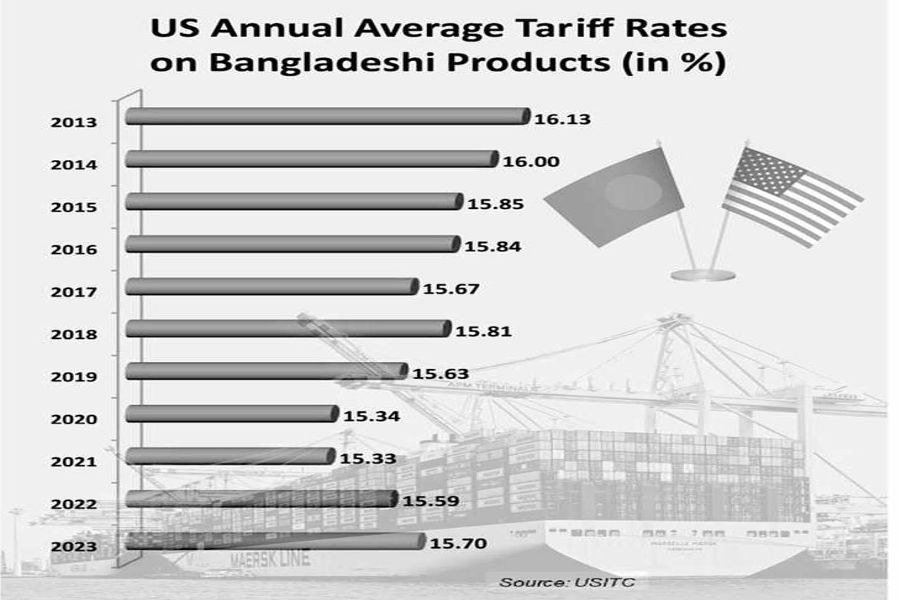
Published :
Updated :

Before he became the 45th President of the United States (US) in 2016, Donald Trump claimed himself as a 'tariff man' who maintained no ambiguity about imposing higher tariffs on imports, mainly from China. After winning the election, he assumed the presidency of the US for four years and initiated a trade war against China by imposing higher tariffs on different products. In 2020, he could not win the election, and Biden became the 46th President of the US. As Trump never gives up, he again joined the presidential race this year and got elected as the 47th President of the world's most powerful country.
His return to the White House is a return of the 'tariff man' who is set to initiate aggressive tariffs on imports from China as well as the rest of the world.
During his presidential campaign, Trump categorically announced that he would impose a 60 per cent tariff on Chinese goods and a 10 to 20 per cent tariff on all goods from other countries. He also vowed to impose at least a 25 per cent tariff on imports from Mexico if the country doesn't address the issue of illegal immigration of Mexicans to the US. Trump's team has already started to work in this direction.
Unlike in his previous term, the preparation to impose tariffs is more hectic this time, and the move will also be aggressive. Some opined that from day one, Trump may impose tariffs through 'executive action under the International Emergency Economic Powers Act.' The law gives the US president broad authority to take trade actions.
It is interesting to note that Biden didn't scrap Trump's tariff hike but rather continued it. According to an analysis prepared by the Tax Foundation, the Trump administration imposed nearly US$80 billion worth of new taxes on Americans by levying tariffs on thousands of products valued at approximately $380 billion in 2018 and 2019. The Biden administration has kept most of the Trump administration tariffs in place and, in May 2024, announced tariff hikes on an additional $18 billion worth of Chinese goods, including semiconductors and electric vehicles.
Trump's restrictive trade policy is poised to cast a significant shadow on Bangladesh's exports to the US market, which is the largest destination of Bangladeshi goods. This is particularly concerning as ready- made garments (RMGs) are the country's major exportable item, accounting for three-fourths of the total exportable goods.
Last year, bilateral trade between the two countries stood at $10.53 billion with trade balance significantly titled towards Bangladesh as total exports to US stood at $8.28 billion. The average tariff on Bangladeshi imports was 15.70 per cent in 2023 when the US customs collected $1.02 billion in customs duties against import of Bangladeshi goods worth $8.28 billion, according to USITC data.
Given the uncertainty surrounding Trump's decision to raise tariffs and his primary focus on China, it is imperative for Bangladesh to readjust its trade policy stance, especially in terms of the upcoming trade policy of the US.
After the GSP was suspended by the Obama administration in 2013, several attempts to revive the trade benefit in the US market failed. The US has made it clear that there is no chance to restore the benefit, although it covered only one per cent of Bangladeshi exports. Later, there was a talk on a bilateral free trade agreement (BFTA) with the US for some time. Again, progress has yet to be made in this connection as the country is not prepared to go for deep economic integration with the US. The cry for tariff-free market access for RMG under the multilateral arrangements has yet to yield any result. Some argue that Bangladesh needs to go for Strategic Trade and Investment Partnership (STIP).
The problem is that Bangladesh has yet to sign and implement an FTA with any of its key trade partners, including India. So, there is an apprehension that it will be pretty difficult to negotiate a BFTA with the US, let alone an STIP. Kenya has been negotiating the STIP with the US for four years. If Bangladesh doesn't negotiate any deal with the US, there will be no chance to unilaterally avail of any trade benefit as Trump's trade policy stresses bilateral negotiation and exchange.
Once again, it's crucial to note that the US is one of the leading sources of foreign direct investment (FDI) in Bangladesh. Last year, 10 per cent of the net FDI came from the US, amounting $315 million. The stock of the country's private sector long-term external credit from the US reached $735.26 million.
Around 11 per cent of the country's remittance also came from the US. This underscores the significant economic tie with the US that Bangladesh needs to further consolidate.
Eleven years back, Bangladesh signed the Trade and Investment Cooperation Forum Agreement (TICFA) with the US, mainly under pressure follwing the Rana Plaza disaster that killed more than 1,100 factory workers and the subsequent suspension of the GSP facility. TICFA provides an extensive opportunity to discuss economic, trade, and labour-related issues bilaterally. TICFA council also provides clear indications and information about the core areas of interest of the US administrations. Workers' rights,
including freedom of association and collective bargaining, are a top priority for the Biden-Harris Administration, and they have been discussed in various TICFA council meetings in the last few years.
Early next year, the Trump- Vance Administration will formally take over, and the USTR will release a new trade policy agenda. The labour issue is likely to remain a priority and Bangladesh has to face further pressure in this connection and possible tariff escalation in the US market.
asjadulk@gmail.com


 For all latest news, follow The Financial Express Google News channel.
For all latest news, follow The Financial Express Google News channel.